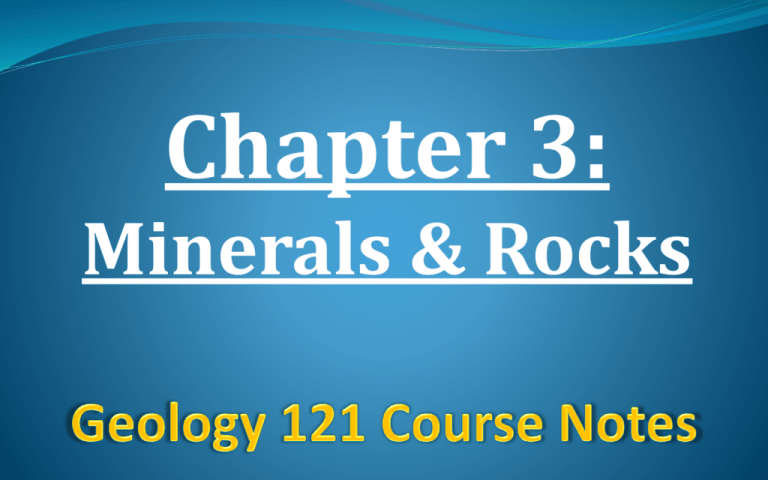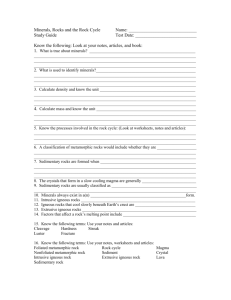File
advertisement

Chapter 3: Minerals & Rocks Add section detail briefings Click here to type in text Periodic Table of the Elements Ionic radius Cations–positively charged atoms Anions–negatively charged atoms The charge on the atom is called valence Anions tend to be larger than cations. The relative sizes of the atoms in their common valence states dictates the three dimensional packing that is possible between cation and anion and, thus, their crystal structure and geometry. Sodium and chloride ions pack in a cubic structure. Chloride ion Sodium ion Each cation is surrounded by six anions, and vice versa. Sodium and chloride ions pack in a cubic structure. Chloride ion Each cation is surrounded by six anions, and vice versa. Sodium ion NaCl crystal Sodium and chloride ions pack in a cubic structure. Chloride ion Each cation is surrounded by six anions, and vice versa. Sodium ion NaCl crystal Lewis diagram for ionic bond Table salt halite Add section detail briefings Silicate ion (SiO44–) The silicate ion forms tetrahedra. Oxygen ions Silicon ion (O2–) (Si4+) Quartz structure Silicate ion (SiO44–) The silicate ion forms tetrahedra. Oxygen ions Silicon ion (O2–) (Si4+) Quartz structure Silicate ion (SiO44–) The silicate ion forms tetrahedra. Oxygen ions Silicon ion (O2–) (Si4+) Lewis diagram for Covalent bonds Quartz structure Silicate ion (SiO44–) The silicate ion forms tetrahedra. Oxygen ions Silicon ion (O2–) (Si4+) Tetrahedra can arrange in other ways. Quartz is a silicate polymorph. Add section detail briefings Mineral Olivine Chemical formula Cleavage planes and number of cleavage directions 1 plane Isolated tetrahedra (Mg, Fe)2SiO4 2 planes at 90° Pyroxene Silicate structure Single chains (Mg, Fe)SiO3 2 planes at 60° and 120° Double chains 1 plane Sheets Amphibole Ca2(Mg, Fe)5Si8O22(OH)2 Micas Muscovite: KAl2(AlSi3O10)(OH)2 Biotite: K(Mg, Fe)3AlSi3O10(OH)2 Feldspars Orthoclase feldspar: KAlSi3O8 Plagioclase feldspar: (Ca, Na) AlSi3O8 2 planes at 90° Three-dimensional framework Specimen Hardness is a property that reflects the strength of the atomic bonding Orthoclase feldspar Quartz Biotite Rocks are naturally occurring aggregates of minerals. Plagioclase feldspar Plagioclase feldspar Orthoclase feldspar Biotite Quartz Rock (granite) Classification of rocks–three types Type of rock and Rock-forming source material process IGNEOUS Melting of rocks Example Crystallization Coarsely crystallized granite Classification of rocks–three types Type of rock and Rock-forming source material process IGNEOUS Melting of rocks Example Crystallization Coarsely crystallized granite SEDIMENTARY Weathering and erosion of Exposed rocks Deposition, burial, and lithification Cross-laminated sandstone Classification of rocks–three types Type of rock and Rock-forming source material process IGNEOUS Melting of rocks Example Crystallization Coarsely crystallized granite SEDIMENTARY Weathering and erosion of Exposed rocks Deposition, burial, and lithification Cross-laminated sandstone METAMORPHIC Rocks under high temperatures and Recrystallization pressures Gneiss Igneous rock forming environments Igneous extrusion (lava) Igneous intrusion Igneous rock forming environments Igneous extrusion (lava) Extrusive igneous rocks form when magma erupts at the surface. Igneous intrusion Igneous rock forming environments Igneous extrusion (lava) Extrusive igneous rocks form when magma erupts at the surface. The resulting rock is fine-grained or has a glassy texture. Igneous intrusion Igneous rock forming environments Igneous extrusion (lava) Extrusive igneous rocks form when magma erupts at the surface. The resulting rock is fine-grained or has a glassy texture. Igneous intrusion Intrusive igneous rocks form when molten rock intrudes into unmelted rock masses. Igneous rock forming environments Igneous extrusion (lava) Extrusive igneous rocks form when magma erupts at the surface. The resulting rock is fine-grained or has a glassy texture. Igneous intrusion Intrusive igneous rocks form when molten rock intrudes into unmelted rock masses. The slow cooling process produces coarsely grained rocks. Add section detail briefings Sedimentary rock forming environments Lake Igneous rock Beach Continental margin Delta Continental Coral shelf reefs Metamorphic rock Particles of rock created by weathering… Lake Igneous rock Beach Continental margin Delta Continental Coral shelf reefs Metamorphic rock Particles of rock created by weathering… ...are transported downhill by erosion… Lake Igneous rock Beach Continental margin Delta Continental Coral shelf reefs Metamorphic rock Particles of rock created by weathering… ...are transported downhill by erosion… …and deposited as layers of sediment… Lake Igneous rock Beach Continental margin Delta Continental Coral shelf reefs Metamorphic rock Particles of rock created by weathering… ...are transported downhill by erosion… …and deposited as layers of sediment… Lake Igneous rock Beach Continental margin Delta Continental Coral shelf reefs …where they form bedding. Metamorphic rock Particles of rock created by weathering… ...are transported downhill by erosion… …and deposited as layers of sediment… Lake Igneous rock Beach Continental margin Delta Continental Coral shelf reefs …where they form bedding. Buried sediments lithify. Metamorphic rock The weight of the sediment deposited at continental margins weighs down upon the ductile mantle. The mantle responds to this additional weight by flowing away from the area of sediment accumulation, thus, making space for more sediments to accumulate. Particles of rock created by weathering… ...are transported downhill by erosion… …and deposited as layers of sediment… Lake Igneous rock Beach Continental margin Delta Continental Coral shelf reefs Siliciclastic sediments are made of deposited particles. …where they form bedding. Buried sediments lithify. Metamorphic rock Particles of rock created by weathering… ...are transported downhill by erosion… …and deposited as layers of sediment… Lake Igneous rock Beach Continental margin Delta Continental Coral shelf reefs Siliciclastic sediments are made of deposited particles. …where they form bedding. Buried sediments lithify. Chemical and biochemical sediments are precipitated from seawater. Metamorphic rock Aragonite : orthorhombic Calcite : trigonal/rhombohedral oysters, cave deposits Corals, gastropods, forams, coccoliths Aragonite and calcite are the two most common forms of CaCO3, called polymorphs. Polymorphs are minerals that have the same chemical formula, but different arrangements of the constituent atoms. Banded iron formations (BIFs) chemical sedimentary rock deposited in Precambrian Oceans when dissolved O2(g) was very low. Kakabeka Falls, near Thunder Bay Metamorphic rock types Trench Continental crust Oceanic crust Continental lithosphere Oceanic lithosphere Asthenosphere Hornfels formation Sediments Magma Hornfels Eclogite Micaschist Blueschist Contact Ultra-highRegional High-pressure, metamorphism pressure metamorphism low-temperature metamorphism metamorphism Add section detail briefings Rift to drift rock formation in a plate tectonic context Sediments are buried to form sedimentary rocks. Sediments are buried to form sedimentary rocks. Sediment Sedimentary rock Magma rises to form igneous rock. Continental lithosphere Oceanic crust Continental crust Magma rises to form igneous rock. Continental lithosphere Oceanic crust Continental crust Magma Igneous rock Subsidence Subsidence leads to formation of sedimentary rock. Subsidence Sediment Sedimentary rock Magma rises and cools to make igneous rock. Igneous Magma rock Rocks are buried deeper, forming metamorphic rocks. Weathering creates loose material that erosion strips away. Rocks are buried deeper, forming metamorphic rocks. Weathering creates loose material that erosion strips away. Metamorphic rock Layers of sediment lithify to form sedimentary rock. Layers of sediment lithify to form Sedimentary sedimentary rock. rock Sediment Sediments are buried to form sedimentary rocks and the cycle begins anew. Sediments are buried to form sedimentary rocks and the cycle begins anew. Slide 72 Sediment Sedimentary rock Groundwater dissolves metal oxides and sulfides. Heated by the magma, it rises, precipitating metal ores in joints. Deformed country rock Geysers and hot springs Groundwater Magma Plutonic intrusion Groundwater dissolves metal oxides and sulfides. Heated by the magma, it rises, precipitating metal ores in joints. Deformed country rock Geysers and hot springs Groundwater Magma Plutonic intrusion Vein deposit








